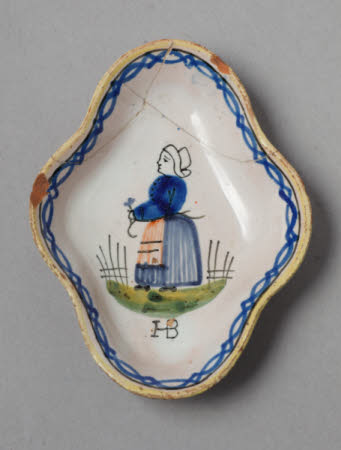Dish
Category
Ceramics
Date
1880 - 1900
Materials
Faience (tin-glazed earthenware)
Measurements
90 mm (Diameter)
Place of origin
Quimper
Order this imageCollection
Hill Top, Cumbria
NT 641561
Summary
Miniature dish or pin tray, faience (tin-glazed earthenware), red terracotta body, lobed quatrefoil form, marked ‘HB’ for the de la Hubaudière factory, Quimper, France, ca 1880-1900; at the centre a woman wearing traditional Breton costume holding a flower, standing on a grass, border pattern of interlaced lines forming a continuous band of diamonds and ovals, yellow edge to rim.
Full description
This dish is part of the collection at Hill Top. Beatrix Potter purchased this farmhouse in the Lake District village of Near Sawrey in 1905, using the profits from her books. After her marriage to William Heelis in 1913, Beatrix relocated permanently to Sawrey. The couple made nearby Castle Cottage their home, but Beatrix spent as much time as she could at Hill Top. As well as a space for work and creativity – and the location for many of her famous tales – it became an intensely personal sanctuary for her. Beatrix knew exactly how she would decorate Hill Top and she arranged its interiors carefully and deliberately. She wrote: ‘I would have old furniture…it is not as expensive as modern furniture, and incomparably handsomer…’ Once she had renovated the farmhouse, she filled it with examples of local furniture and treasured heirlooms, like her grandmother’s warming pan and a set of plates decorated with designs by her father. The 1914 inventory of Beatrix’s family home, Bolton Gardens, South Kensington, lists ‘Bretaigne ware and Amphora, decorated fleur-de-lys etc. in blue’ in the Drawing Room, which might refer to this piece and others from the same group. A number of ceramics from Hill Top are recognisable in Beatrix’s artworks and a few were used in illustrations for her tales. This dish frames the left edge of a scene in The Tailor of Gloucester in which the mice stand on the dresser, watching the tailor as he worries about the Mayor’s unfinished coat (The Mice Listen to the Tailors’ Lament, 1902, Tate, A01098). Of her books, The Tailor of Gloucester was one of Beatrix’s favourites. She published it privately in 1902 and it was released by her publisher the following year. Beatrix was staying in Stroud with her cousin, Caroline Hutton, when the story that formed the basis of The Tailor was recounted to her and she decided to develop it into her own tale. She travelled into Gloucester, sketching in the streets and around the cathedral. Beatrix was allowed to make sketches in a few cottages and captured the details of their interiors, including a dresser filled with brightly coloured ceramics, probably at Harescombe Grange near Stroud (V&A, Linder Collection, LC.9.A.1). Beatrix also visited a tailor’s shop in Chelsea and the Victoria and Albert Museum, where she sketched the beautiful eighteenth century waistcoat that features in the story (V&A 652A-1898).
Provenance
From Troutbeck Park.
References
Conroy 2023: Rachel Conroy, ‘A love of ‘old china, especially earthenware’: ceramics at Beatrix Potter’s Hill Top and in her ‘little books’, Transactions of the English Ceramic Circle (Volume 34, 2023), 95-112
